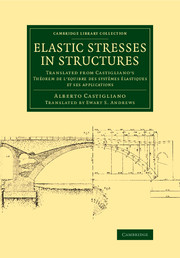
-
Select format
-
- Publisher:
- Cambridge University Press
- Publication date:
- June 2016
- September 2014
- ISBN:
- 9781107279933
- 9781108070263
- Dimensions:
- Weight & Pages:
- Dimensions:
- (244 x 170 mm)
- Weight & Pages:
- 0.64kg, 400 Pages
You may already have access via personal or institutional login
Book description
Many of the modern methods of structural analysis based on concepts of virtual work and energy were developed and popularised in Italy in the latter half of the nineteenth century. Building on the work of Luigi Menabrea, the mathematician Carlo Alberto Castigliano (1847–84) provided the first full proof of these methods in his 1873 dissertation while based in Turin. Equally important was his popularisation of the theory in his Théorie de l'équilibre des systèmes élastiques et ses applications (1879), in which he applied his theory to a wide range of important real-world cases. The work is here reissued in its 1919 English translation, by the consulting engineer and lecturer Ewart S. Andrews. Castigliano covers the basic theory of elastic stresses, introducing useful approximations; he then moves on to the analysis of real structures, including roof trusses, arches and bridges in both iron and masonry.
Contents
Metrics
Full text views
Full text views help Loading metrics...
Loading metrics...
* Views captured on Cambridge Core between #date#. This data will be updated every 24 hours.
Usage data cannot currently be displayed.
Accessibility standard: Unknown
Why this information is here
This section outlines the accessibility features of this content - including support for screen readers, full keyboard navigation and high-contrast display options. This may not be relevant for you.
Accessibility Information
Accessibility compliance for the PDF of this book is currently unknown and may be updated in the future.


